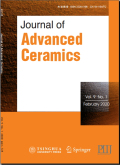- 钛学术文献服务平台 \
- 学术期刊 \
- 工业技术期刊 \
- 化学工业期刊 \
- 先进陶瓷(英文版)期刊 \
Theoretical prediction, synthesis, and crystal structure determination of new MAX phase compound V2SnC
Theoretical prediction, synthesis, and crystal structure determination of new MAX phase compound V2SnC
基本信息来源于合作网站,原文需代理用户跳转至来源网站获取
摘要:
Guided by the theoretical prediction,a new MAX phase V2SnC was synthesized experimentally for the first time by reaction of V,Sn,and C mixtures at 1000 ℃.The chemical composition and crystal structure of this new compound were identified by the cross-check combination of first-principles calculations,X-ray diffraction (XRD),energy dispersive X-ray spectroscopy (EDS),and high resolution scanning transmission electron microscopy (HR-STEM).The stacking sequence of V2C and Sn layers results in a crystal structure of space group P63/mmc.The a-and c-lattice parameters,which were determined by the Rietveld analysis of powder XRD pattern,are 0.2981(0) nm and 1.3470(6) nm,respectively.The atomic positions are V at 4f (1/3,2/3,0.0776(5)),Sn at 2d (2/3,1/3,1/4),and C at 2a (0,0,0).A new set of XRD data of V2SnC was also obtained.Theoretical calculations suggest that this new compound is stable with negative formation energy and formation enthalpy,satisfied Born-Huang criteria of mechanical stability,and positive phonon branches over the Brillouin zone.It also has low shear deformation resistance c44 (second-order elastic constant,cij) and shear modulus (G),positive Cauchy pressure,and low Pugh's ratio (G/B =0.500 < 0.571),which is regarded as a quasi-ductile MAX phase.The mechanism underpinning the quasi-ductility is associated with the presence of a metallic bond.

推荐文章
Incorporation of silica into the goethite structure: a microscopic and spectroscopic study
Quartz
Goethite
Twinned goethite
Microscopic characterization (FESEM and TEM)
FT-IR spectroscopy
微波诱发自蔓延高温反应合成Ti2SnC材料
Ti2SnC
微波合成
自蔓延高温合成反应
活性碳
碳黑
Determination of brominated diphenyl ethers in atmospheric particulate matter using selective pressu
Brominated diphenyl ethers
Atmospheric particulate matters
Selective pressurised liquid extraction
Gas chromatography-mass spectrometry
内容分析
关键词云
关键词热度
相关文献总数
(/次)
(/年)
引文网络
引文网络
二级参考文献 (6)
共引文献 (16)
参考文献 (43)
节点文献
引证文献 (0)
同被引文献 (0)
二级引证文献 (0)
1952(1)
- 参考文献(1)
- 二级参考文献(0)
1964(1)
- 参考文献(1)
- 二级参考文献(0)
1977(1)
- 参考文献(1)
- 二级参考文献(0)
1978(1)
- 参考文献(0)
- 二级参考文献(1)
1993(1)
- 参考文献(1)
- 二级参考文献(0)
1996(2)
- 参考文献(2)
- 二级参考文献(0)
1997(1)
- 参考文献(1)
- 二级参考文献(0)
1998(1)
- 参考文献(1)
- 二级参考文献(0)
1999(1)
- 参考文献(1)
- 二级参考文献(0)
2000(2)
- 参考文献(1)
- 二级参考文献(1)
2001(3)
- 参考文献(1)
- 二级参考文献(2)
2002(1)
- 参考文献(1)
- 二级参考文献(0)
2004(2)
- 参考文献(1)
- 二级参考文献(1)
2005(1)
- 参考文献(1)
- 二级参考文献(0)
2006(4)
- 参考文献(3)
- 二级参考文献(1)
2007(2)
- 参考文献(2)
- 二级参考文献(0)
2008(2)
- 参考文献(2)
- 二级参考文献(0)
2009(4)
- 参考文献(4)
- 二级参考文献(0)
2010(2)
- 参考文献(2)
- 二级参考文献(0)
2012(2)
- 参考文献(2)
- 二级参考文献(0)
2013(1)
- 参考文献(1)
- 二级参考文献(0)
2015(1)
- 参考文献(1)
- 二级参考文献(0)
2016(3)
- 参考文献(3)
- 二级参考文献(0)
2017(2)
- 参考文献(2)
- 二级参考文献(0)
2018(2)
- 参考文献(2)
- 二级参考文献(0)
2019(5)
- 参考文献(5)
- 二级参考文献(0)
2020(0)
- 参考文献(0)
- 二级参考文献(0)
- 引证文献(0)
- 二级引证文献(0)
引文网络交叉学科
相关学者/机构
期刊影响力
先进陶瓷(英文版)
主办单位:
清华大学
出版周期:
季刊
ISSN:
2226-4108
CN:
10-1154/TQ
开本:
出版地:
邮发代号:
创刊时间:
语种:
eng
出版文献量(篇)
290
总下载数(次)
0
总被引数(次)
157
期刊文献
相关文献
推荐文献

 免费查重
免费查重










